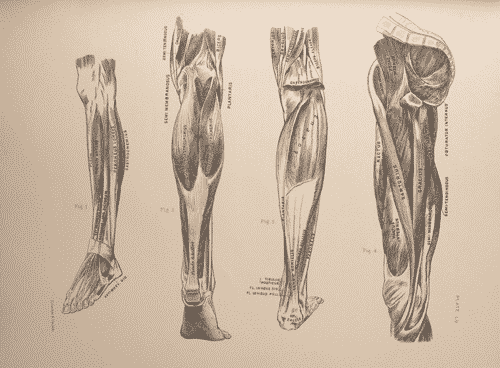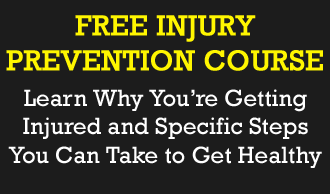It’s not surprising to know that if you’re a runner, it’s likely that at some point you’ll experience pain in your feet. But, figuring out why your feet might be hurting isn’t quite as clear.
Your feet are exceptionally complex anatomical structures.
They’re made of no fewer than twenty-six bones, with over one hundred muscles, tendons, and ligaments controlling their movement. And they have a huge brace of responsibility in your gross body movement. Balance, stability, arch support, and forward propulsion are just a few of the foot’s daily tasks as we walk and run around in day-to-day life.
Some coaches and text suggest that we should be able to walk a minimum (yep, a minimum) of ten thousand steps a day – roughly five miles a day before we start adding in our running training.
That’s a pretty heavy workload for a relatively small collection of bones in our body. And of course, many of start running without this prerequisite.
With that in mind, I can’t stress enough that runners’ feet won’t just benefit from but positively require a great deal of care and attention.
So, in this article we’re going to look at how your foot works as it relates to running (so you can understand the why), help you uncover different reasons your foot may be hurting, and finally help you fix your issues.
Anatomy of the Foot
There are three critical areas we look at when assessing the health of our feet: the intrinsic and extrinsic muscles, and our core or torso.

The intrinsic muscles control more refined movements like individual toe moving and arch support in the foot. The extrinsic muscles start in the legs and end at the feet, controlling our foot as we direct it in, out, up, and down.
Where does the core come in? The foot is like all of our major limbs. The core is the central operator of all of our locomotion. A strong core means strong feet.
These are the three critical muscle areas we’re going to look at closely and troubleshoot today. Let’s start with the intrinsic muscles.
The Intrinsic Muscles
The intrinsic muscles have a deceptively heavy workload, as we have not one, but three arches to support within the foot: the medial (inside) arch, the lateral (outside) arch, and the anterior transverse (front and across) arch.
You can check yourself for intrinsic weakness right now by taking your foot off the floor. Do you have an arch when you’re not weight bearing? If you do, your intrinsic muscles are weak, and will produce an injury at some point in your training
What Can Go Wrong
The intrinsic muscles support all of these arches, and if we neglect them a plethora of problems arise. These are the examples I frequently see as a physio:
Pes planus (Flat foot): Here, the medial arch collapses and a bone called your navicular drops. A lot of people think are born with flat feet, but more often than not, it is the ankle that has collapsed from weak intrinsic muscles.
Hallux valgus (Bunions): Most commonly caused by wearing high heels, bunions can also be due to chronic intrinsic (as well as extrinsic) muscle instability. This instability increases the pressure on the inside of the foot, and the ball of the foot spreads to compensate and restabilise the foot. The result? Bunions, though such an adaptation can cause a cascade of issues in other areas as well. Here’s our in-depth guide to fix bunions.
Plantar fasciitis: The plantar fascia is a thick band of fibers that runs from the base of the heel to the metatarsal heads. The tell-tale sign is a sharp or dull pain in your heel, especially after your run. Here’s out in-depth guide on how to treat and prevent plantar fasciitis.
Here’s how you can avoid running into them yourself.
How to Prevent Intrinsic Muscle Weakness
- Practice picking up pens, pencils, and other small objects with your toes and putting them in a bowl.
- Scrunch a towel underneath your feet.
- Perform heel raises or walk on your toes.
A few minutes a day of each can go a long way towards strengthening your intrinsic foot muscles.
The Extrinsic Muscles
There are six extrinsic muscles that work to move your foot in all its various directions. If you try and draw the alphabet with your toes, you’ll see these muscles at work, and the many directions your foot can move.
What Can Go Wrong
Calf Injuries: The most commonly known extrinsic muscles are your calf muscles (the gastrocnemius and the soleus), responsible for pointing your toes down into plantar flexion. Here’s how in-depth guide to prevent and treat calf injuries.
Tibialis anterior: If this muscle is tight or weak in runners, it most often presents as painful shin splints and lateral (outer) knee pain. Here’s an in-depth guide on how to treat and prevent tibialis anterior injuries.
Ankle sprains: Ankle sprains, as you might guess, always occur after a sudden and jarring impact, landing, or twisting of the ankle. You might hear or feel a “pop” followed by a sharp pain. You’ll often have throbbing or aching pain in your ankle even when you’re not putting weight on it, and you’ll have a sharp pain if you passively rotate your ankle into inversion or eversion. Here’s our in-depth guide for treating ankle injuries.
Achilles tendonitis: Achilles tendonitis typically starts off as a dull stiffness in the tendon, which gradually goes away as the area gets warmed up. It may get worse with faster running, uphill running, or when wearing spikes and other low-heeled running shoes. Here’s our in-depth guide on how to treat and prevent achilles injuries.
How to Prevent Extrinsic Muscle Weakness
BALANCE. BALANCE EVERYWHERE. Balance is the best way to strengthen your extrinsic muscles.
Try balancing with your feet together, staggered, with your eyes open or closed, on one leg, on one leg with eyes closed, on uneven surfaces (like walking around in both directions on the edge of a rug), balancing on your heels or toes, balancing whilst moving your arms and legs in different directions, or whilst throwing or catching a ball.
Here’s a good recap of more balance exercises for you.
The Core/Hip Muscles
As we’ve said, there’s a lot of pain felt in a runner’s feet that has very little to do with the feet themselves. It’s usually due to the runner in question having a weak core.
In addition to strength, if we have a stable core, we can be stable at the joints next to the torso. If those are stable, we can be stable at the joints in the hips. If the hips are stable, so too will the knees. And if the knees are, so are the ankles.
Conversely, if we have a weak core, the problem cascades down through the hips, knees, and ankles, and our feet will always be working harder than they need to to counteract the weaknesses above them.
This is why as physios we sometimes treat foot pain with hip stability exercises. We’re not crazy, and did listen to what you said – we’re merely addressing the cause of the problem up the movement chain.
Other common running injuries arising from weak core muscles include: runner’s knee (clinically known as patellofemoral malalignment and/or IT band syndrome), and bursitis, usually around the hip or the knee area.
We’ll say it again: an inherently weak core causes a storm of issues down the movement chain. Foot pain almost always point to core weakness. Get a strong core. Your body and your running will thank you for it.
Foot Pain Is Rarely Caused Within the Foot Itself
As you can see, in runners, there’s a lot of issues that arise in the feet that have very little to do with the feet themselves. If you’re unsure where to start, or where your foot pain is originating from start with working your core.
We are designed to be weight bearing, free running creatures. Unfortunately, our modern sedentarism doesn’t keep our core in good enough shape to run the way that we are supposed to. If you want to reclaim your running birth right, begin regularly exercising your core, and watch the health and strength of your feet follow




